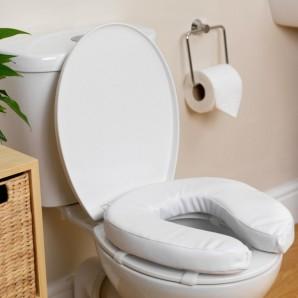After losing one’s mobility due to illness or disability, routine tasks previously taken for granted become difficult. If you are bedbound and unable to get to the bathroom, items like commodes and other mobility aids may become necessary.
The inability to make the trip to the toilet presents a practical problem, but there is plenty of great equipment to help. Bedside commodes are essentially mobile toilets. They do not have a flush or running water supply, but instead use a plastic pan which fits underneath the seat. The user sits on it as they would a normal WC. The pan needs emptying after use.
You Will Need Help
Commodes are roughly the same height as a toilet and most people position them next to the bed. In almost all cases you will need assistance to move from the bed onto the commode chair. You will also need someone to remove the pan, clean it and refit it to the commode.
Many commodes come as discreetly designed wood-finished units. These fit in with the room furniture and don’t look too conspicuous. It is natural for some people to feel embarrassed at having to use this kind of toileting equipment. These discreet designs may go some way to disguising the issue.
Other types of commode fold away when not in use. Their frames collapse down for storage. Steel or aluminium framed commodes usually have a plastic seat. Aluminium is lighter in weight and less prone to corrosion. Steel frames have a wipe-clean powder coating and are heavier.
The legs of folding commodes need rubber stoppers on the ends. These act to prevent the feet from slipping and are important safety features. If you are helping someone from a bed onto a commode, it is crucial to first ensure that the commode is as stable as possible. If it is a folding model, make sure that it is fully open before anyone sits on it.
Transfer from Bed
Position the commode as near to the bed as possible, making for a short distance of travel. Bear in mind that the commode chair’s seat is likely to be lower than the bed. The person will need a lot of support as they move down and back up afterwards.
Sometimes this bed-to-commode transfer is easier when using a transfer board. These aids create a ‘bridge’ from the bed to the chair, enabling the person to edge from one to the other. Transfer boards are available in various sizes.
As well as the static models, mobile commodes are also available. These have wheels which means they act as wheelchairs for short distances if required. It is important to fully engage the brakes before transferring someone from the bed to the chair. Some models with non-rusting components are suitable for use in wet rooms under the shower.
Commodes come with a bucket or pan which fits beneath the seat. These usually have a quick release mechanism for easy disconnection. Most people choose to partially fill the pan with tap water before use.
Hygiene
Hygiene is a big consideration. Disinfection of all the commode’s surfaces is important to prevent the spread of germs. It is essential to wash-out and disinfect the pan itself.
Toilet Seat Comfort
Commode chairs can have uncomfortable seats. If this is the case, using a padded toilet seat might be a good option. These are particularly useful aids if the person has skin which is easily broken.
A padded toilet seat is either circular, or U-shaped. It fits to the existing seat by means of straps, which hold it in place. It provides an extra degree of comfort when sitting down. Foam-filled and inflatable toilet cushions are available.
When using with a standard WC, many people who have difficulty standing up or sitting down, use a raised padded toilet seat. Raising the overall height of the seat puts slightly less stress on the body.













No Comments